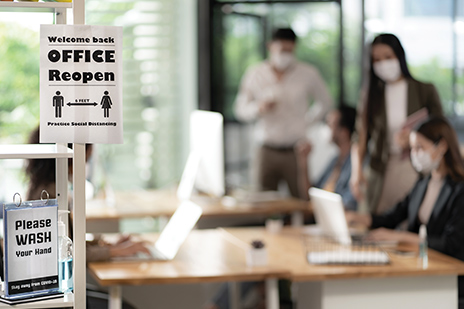In the second part of our feature on business recovery, Thijs Deweerdt Senior Manager – Certified Internal Auditor at EY Consulting, discusses the key considerations for companies to make the best of opportunities available as they rebuild after the pandemic
The effect of COVID-19 on the world economy can be described as a K-shaped consequence. For some sectors, the crisis has had a positive impact on their profitability; these include medical protection suppliers, online shopping platforms and bike stores. Others, such as the moving industry have, unfortunately, often been impacted in negative ways, hence these are located at the lower part of the K model.

The repercussions – and thus the recovery – can be different depending on the region in which the company is located. The FIDI network can help Affiliates share insights on how to recover and how to change to new ways of working. Some regions might already be in the recovery phase, while others are still suffering the effects of the initial blows. Good communication about the do’s and don’ts can help other Affiliates head in the right direction.
It is important to focus on what can be influenced and the common challenges for all Affiliates in the moving industry. At EY, we suggest a two-geared approach. The first gear focuses on mitigating risks for employees and customers to enable a trusted transition back to physical operations; the second explores how to reimagine work, transforming your organisation for the better. Leaders must become masters at applying lessons from the pandemic to both gears, continuing to learn, develop and improve their businesses for the better.
Here, we have listed key considerations of this approach for employees and clients.
GEAR 1: CONSIDERATIONS FOR A TRUSTED TRANSITION – QUESTIONS YOU NEED TO ASK
Employees:
- How are you prioritising the health and wellbeing of employees in their physical return to work and/or remote working?
- How will you make your staff feel safe in their physical return to the office and productive if they continue to work from home?
- Are you equipping your workers with the tools and technology to feel safe and be productive and connected?
Customers:
- What is your playbook for protecting the health and safety of your customers?
- How are you changing your physical environment to adjust to new preferences and keep customers safe?
- How will you use technology to improve collaboration, learning and new ways of working?
GEAR 2: CONSIDERATIONS FOR WORK/SERVICE REIMAGINED – KEY QUESTIONS
Employees:
- How will you address chronic and acute wellbeing issues (physical, financial, social and emotional) in a transformation road map?
- Do your physical work environment and work-from-home policies reflect employee preferences, choice and a new workforce model?
- How will you use technology to increase collaboration, learning and new ways of working?
Customers:
- How will you embrace and promote customer cultural and behavioural shifts?
- How will you reimagine customer contact in your physical space to create more or better value for your customer?
- How will you reinvent business and delivery models to enhance the customer experience?
REBOOTING THE MOBILITY BUSINESS
For the reboot of the mobility business, we refer to the second gear mentioned above. The traditional moving model is under great pressure, but there is also an opportunity in customer service. For, example, the COVID-19 crisis is being tackled differently in each country/region, so it is almost impossible for customers to get a total overview of what is and what is not allowed in each country.
The FIDI network can be used well to transfer this kind of information between the Affiliates to give the customer the most detailed information possible. It will be important to relieve as much pressure/uncertainty as possible for the clients.
As previously reported in FIDI Focus, companies should be focusing on digital tools, including virtual surveys, digital packing lists and digital moving files, so employees can continue their work and physical contact with clients is reduced to an absolute minimum.
LEGAL ISSUES
Meanwhile, because of COVID-19, the risk of receiving claims has become a lot higher. It is important to check if claim policies include a pandemic as a
force majeure or not. We would strongly advise all Affiliates revisit their policies and procedures in line with the current situation. However, we should also strongly emphasise the importance of open communication with your supply chain – and that includes your customers.
TWELVE INSIGHTS FOR BETTER BUSINESS RECOVERY
EY has curated the following 12 important insights on the approach businesses should consider taking during the next stage of the pandemic. In two parts, here is a summary of these.
PART 1: REOPENING AND REBOOTING
1. Reimagine and transform
Getting back up and running requires more than just business as usual, says EY. It’s a balance of transitioning safely into new working world, actively transforming the working conditions and practices caused by COVID-19 (see the two-geared approach described by Deweerdt) opposite.
2. Address customer anxiety
The pandemic has caused permanent changes to consumer behaviours and the way they interact with many businesses – think about the steep growth in online deliveries during lockdown, for example. Firms need to study and understand this new breed of anxious consumer.
3. Rethink the workplace
Working at home is viable for some businesses, while for others being on site is essential. In both cases, companies must redesign their operations with a new focus on safety of staff and customers. This process will involve prioritising cooperation, communication and accountability and be assisted by technology, such as crowdsourcing and new collaboration platforms.
4. Maximise your people’s potential
Looking after your staff is as important for your business as it is for them. It is vital to engage with your workforce to understand and react to their expectations of how they should be looked after.
5. Identify legal risks
Legal action brought about as the result of cancelled contracts, aggrieved employees or other reasons may be a significant source of concern for businesses in the short to medium term. EY recommends modelling potential outcomes, identifying potential risks and capturing data to mitigate the impact.
6. Learn lessons from peers
With restrictions easing (and some being reintroduced), speak to those in other industries and markets who have gone through the process already. As the first country affected by the pandemic, China, for example, provided a useful case study from which others could learn.
PART 2: CAPITAL AND STRATEGY – THINKING, PLANNING AND RESPONDING
7. Adapt operations, increase resilience
There are chances as well as challenges arising from COVID-19. The significant economic and social impact allows for radical changes in how businesses operate – it gives the opportunity, says EY, ‘to transition from a growth economy to a value-based one, prioritising long-term value and resilience and the needs of multiple stakeholders over short-term growth’.
8. Forecast better
Better financial decisions in the post-COVID world is imperative, which in turn make effective forecasting and scenario planning critical. And in an uncertain world, this won’t always be a simple task.
9. Adapt to new expectations
EY’s Future Consumer Index showed customers had a renewed focus on affordability and healthcare concerns, with 70 per cent of respondents saying they are now more health conscious. Businesses must respond with new digital platforms and increasing transparency in their operations.
10. Find the right divestments
An EY survey showed 64 per cent of firms in the Asia-Pacific region thought the crisis would require them to reduce debt through divestment measures.
11. Encourage inward investment
COVID-19 hit foreign direct investment (FDI) hard, with many firms planning to cancel or delay investment plans, according to EY. However, there remain opportunities and new ones are emerging.
12. Stabilise the economy
Everyone in business can contribute to the process of reassuring and supporting individual customers in the wake of the pandemic and, says EY, ‘banks will have a particularly important role to play in the longer-term, post-crisis stabilisation of the global economy’. Businesses should establish close relationships with their banks to manage ‘the inevitable risks of an uncertain environment and secure ongoing access to the capital that will be essential for their long-term recovery and growth’.
You can explore EY’s insights in more depth in its articles available at www.ey.com

